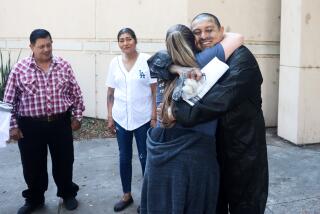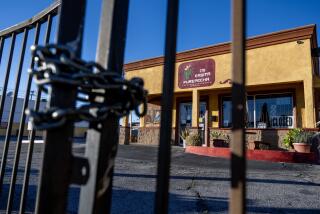Jury Selection Begins in Negligence Trial Over Crash of Subaru Brat : Courts: A youth seated in the bed of the vehicle was badly injured when it went off the road. He is suing the manufacturer for damages.
- Share via
Israel Echevarria was just three weeks away from finishing his studies at Oxnard High School and joining the Navy.
A fun-loving 18-year-old, he was known at his school as a handsome athlete with brains to match.
Then came the crash.
On Aug. 2, 1992, the dark-haired teen-ager was riding in the bed of a Subaru Brat, in the vehicle’s trademark rear-facing seat. The driver crashed into a ditch, tossing Echevarria nearly 40 feet. He landed on his head and did not awake from a coma until three months later.
Today in Ventura County Superior Court, jury selection will begin to determine whether the auto maker is liable for Echevarria’s injuries--which included the loss of his left arm.
A lawsuit accuses Subaru of America and Fuji Heavy Industries Ltd. of negligence for placing passenger seats in the back of an open cargo bed.
Echevarria, now 21, is the latest plaintiff to sue Subaru. From 1981 to 1988, seven other plaintiffs have filed lawsuits for injuries and deaths suffered while riding in a Brat, a small, pickup-size vehicle marketed to young people.
Most of those cases have been settled out of court, according to Echevarria’s lawyer, Edward Steinbrecher.
According to federal transportation officials, 10 passengers who were riding in the rear of Subaru Brats have died in accidents since 1978, when the vehicle was first sold in the United States.
Subaru lawyers would not comment on the Echevarria lawsuit, but have argued in court that Echevarria should have known the dangers of riding in the bed of the Brat. They have said the Brat is no more dangerous than a convertible.
“We will introduce evidence that this vehicle is not unique,” Richard Bowman, Subaru’s Minneapolis-based lawyer, told Judge Joe D. Hadden during pretrial motions last week.
*
But advocates for Echevarria disagree. From 1978 to 1985, the Brat was the only vehicle sold in the United States with seats in its rear bed, they contend.
With the rear seats, the Subaru Brat qualified as a “recreational vehicle” instead of a pickup truck, said Steinbrecher. That distinction allowed the auto maker to pay a 3% tariff as opposed to the 25% import tax on pickup trucks, he said.
Steinbrecher said Subaru saved as much as $100 million on the more than 80,000 Brats imported into the United States from 1978 to 1985--when it removed the rear-facing seats.
In 28 other countries where tariffs were lower, the Brat was sold without rear seats, Steinbrecher said.
“They just stuck these cheap plastic seats back there to get past Customs,” he said. “Only in the United States did they put this dangerous product on the market. This is the stupidest thing I’ve ever heard of.”
Echevarria was injured about 6 p.m. on a bright, sunny Sunday. After finishing his job as a restaurant cashier, he had decided to head for the beach with two friends.
Nathan Stevens, 18, drove his 1980 Brat. Joel Harris, 16, sat in the front with Stevens. Echevarria plopped in the rear, in a seat behind the driver.
Steinbrecher said Stevens was headed westbound on Teal Club Road when Echevarria blurted out his name. The driver turned to hear his friend and lost control of the vehicle, which went into a drainage ditch.
Echevarria was thrown 37 feet and landed on his head, Steinbrecher said. He rolled another 25 feet and came to rest at the bottom of the ditch.
At the time, there was no seat-belt law for pickup trucks in California. One went into effect Jan. 1, 1994. Steinbrecher said police concluded that none of the youths were under the influence of alcohol or drugs.
When he left the hospital that next March, Echevarria was almost completely paralyzed, said his mother, Patricia Echevarria, 43. She said he could barely speak and could not hold his head up. Once a solid 145 pounds, he weighed only 86 pounds.
Before the accident, the dark-haired plaintiff was three weeks from completing his course at Oxnard High. He was headed for San Diego and a tour of duty in the U.S. Navy.
“Israel was the best-looking kid you’ve ever seen. He swam, surfed, played football,” Patricia Echevarria beamed. “He was a trigonometry genius. They had him teaching in summer school because his aptitude was very high.”
George Echevarria, Israel’s father, blamed Subaru for marketing the Brat as a “fun and sun vehicle.” He said the auto maker’s advertising, which featured bikini-clad models and surfboards, was designed to attract young passengers to sit in the rear.
“The way the seats are situated, the way it’s put together--it’s just a deathtrap,” the father said.
*
Using his right hand to guide his wheelchair around the living room of the family’s Oxnard apartment, Israel Echevarria prefers to leave the talk about the lawsuit to his attorney and parents.
Asked if he is looking forward to his day in court, he said his main hope is to prove that the doctors are wrong when they say he will remain in his wheelchair for the rest of his life.
“I’m looking forward to walking,” he said.






